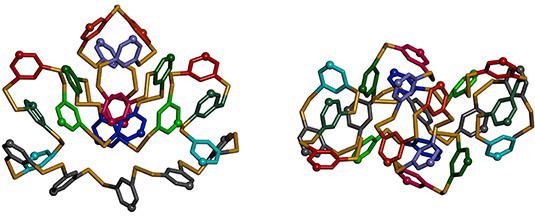Nov 23 2020
Life on Earth primarily depends on the self-organization and production of biological macromolecules.
 Two views of the main chain of the crystal structure of a perfectly unimolecular 23mer that spontaneously forms from a single monomer. Image Credit: Huc Group.
Two views of the main chain of the crystal structure of a perfectly unimolecular 23mer that spontaneously forms from a single monomer. Image Credit: Huc Group.
Chemists from Ludwig-Maximilians-Universitaet (LMU) based in Munich have now reported the spontaneous emergence of intricate ring-shaped macromolecules that have low levels of symmetry in laboratory settings.
Molecules composed of numerous repeating subunits, called monomers, are categorized as polymers or macromolecules. Monomers may have the same or different chemical structures.
Nature contains several examples, such as nucleic acids and proteins, which form the core of all biological systems. In addition to forming the basis of structural elements found in all the cells, proteins also act as enzymes. These enzymes catalyze essentially all the countless range of chemical transformations that occur in living systems.
On the other hand, nucleic acids like RNA and DNA act as informational macromolecules. And it is the DNA that preserves the genetic information of a cell. This information is selectively copied into RNA molecules that offer the blueprints for protein synthesis. Furthermore, long chains containing sugar units offer energy reserves in the form of glycogen, which, in turn, is preserved in the muscles and the liver.
Such different groups of polymeric molecules collectively share a common feature—they spontaneously fold into typical spatial conformations, for instance, the well-known DNA double helix, which in a majority of the cases are crucial for their biochemical functions.
Ivan Huc, a Professor from the Department of Pharmacy at LMU, investigates aspects of the self-organization processes that allow macromolecules to assume definite folded shapes.
Nature contains many molecular structures that provide Huc with several models. Huc attempts to simulate the properties of these models in laboratory settings using non-natural molecules that are not nucleic acids, proteins, or sugar-like molecules.
To be more specific, Huc utilizes the tools of synthetic chemistry to describe the fundamental principles of self-organization; he does this by building molecules that are expressly developed to fold into pre-established shapes.
Starting with monomers designed by his team, Huc set out to create the so-called “foldamers,” by organizing the monomers in a sequential manner to produce a folded macromolecule.
Structures with Low Degrees of Symmetry
The normal way to get the complex structure of proteins is to use different types of monomers, called amino acids. And the normal method to connect different amino acids in the correct order is to link them one by one.
Ivan Huc, Professor, Department of Pharmacy, Ludwig-Maximilians-Universitaet
The series of amino acids comprises the folding data that enable different sequences of proteins to fold in different manners. “But we discovered something unexpected and spectacular”,” added Huc.
Along with his collaborators in Munich, Bordeaux, Groningen, and Berlin, Huc utilized organic, sulfur-containing monomers to spontaneously obtain cyclic macromolecules that have an intricate shape. These macromolecules are defined by their low degree of symmetry, without needing a particular sequence. The macromolecules synthesize on their own, without requiring additional conditions
We only put one monomer type in a flask and wait. This is typical for a polymerization reaction, but polymers from a single monomer usually don´t adopt complex shapes and don’t stop growing at a precise chain length.
Ivan Huc, Professor, Department of Pharmacy, Ludwig-Maximilians-Universitaet
To additionally regulate the reaction, the researchers also employed a metal ion or a tiny guest molecule. The regulator attaches inside the growing macromolecule and drives monomers to organize themselves around it.
By selecting a regulator with suitable characteristics, the study’s authors successfully created structures that have a pre-established number of subunits. The cyclic macromolecules had a low degree of symmetry, with a few containing 23, 17, or 13 subunits. Since 13, 17, and 23 are all prime numbers, the equivalent folded shapes have low levels of symmetry.
A Model for Biological and Industrial Processes
But interest in the clarification of these mechanisms is not limited to the world of fundamental studies. According to Huc and his collaborators, the new method will result in the development of designer plastics.
Most often, traditional polymers contain a combination of molecules that have different lengths (that is, the number of monomers present in them). This kind of heterogeneity affects the physical properties of these molecules. Therefore, the potential to produce polymer chains of a precise length and/or geometry is anticipated to result in materials that exhibit fascinating and novel behaviors.
Moreover, foldamers like those that have currently been produced almost have the same structural resemblances to biopolymers. Therefore, these foldamers serve as a perfect model system, wherein the characteristics of proteins can be analyzed.
Each protein is composed of a defined linear (that is, unbranched) series of amino acids, which makes up its “primary structure.” However, a majority of the amino-acid chains fold into local substructures, such as parallel strands that can create sheets or helically coiled stretches.
Such units denote the secondary structure of a protein. The word “tertiary structure” is used on the fully folded single chain. This, consequently, can form a quaternary structure or a functional unit by interacting with other chains.
The ultimate objective of Huc is to imitate the complex biological mechanisms with the help of synthetic and structurally defined precursors. He wants to find out how, for instance, enzymes fold into the accurate, biologically active conformation after they are produced in cells.
Molecules whose characteristics can be accurately regulated in laboratory settings serve as perfect models, which can be used to find out the answers and, maybe, to go beyond the enzymes themselves.
Journal Reference:
Pappas, C. G., et al. (2020) Emergence of low-symmetry foldamers from single monomers. Nature. doi.org/10.1038/s41557-020-00565-2.